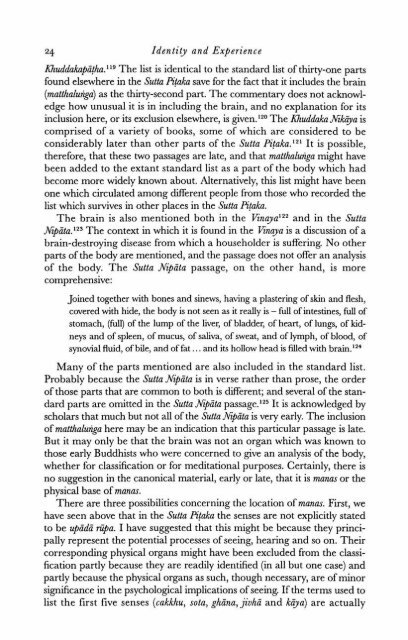Identity and Experience_Hamilton_1996
Identity and Experience_Hamilton_1996
Identity and Experience_Hamilton_1996
You also want an ePaper? Increase the reach of your titles
YUMPU automatically turns print PDFs into web optimized ePapers that Google loves.
24 <strong>Identity</strong> <strong>and</strong> <strong>Experience</strong><br />
Khuddakdp@ha.lLg The list is identical to the st<strong>and</strong>ard list of thirty-one parts<br />
found elsewhere in the Sutta Pitaka save for the fact that it includes the brain<br />
(matthaluriga) as the thirty-second part. The commentary does not acknowledge<br />
how unusual it is in including the brain, <strong>and</strong> no explanation for its<br />
inclusion here, or its exclusion elsewhere, is given.Iz0 The Khuddaka JVihya is<br />
comprised of a variety of books, some of which are considered to be<br />
considerably later than other parts of the Sutta Pi!aka.l2l It is possible,<br />
therefore, that these two passages are late, <strong>and</strong> that matthalunga might have<br />
been added to the extant st<strong>and</strong>ard list as a part of the body which had<br />
become more widely known about. Alternatively, this list might have been<br />
one which circulated among different people from those who recorded the<br />
list which survives in other places in the Sutta &aka.<br />
The brain is also mentioned both in the Enaya122 <strong>and</strong> in the Sutta<br />
N$~iita.l~~ The context in which it is found in the Enaya is a discussion of a<br />
brain-destroying disease from which a householder is suffering. No other<br />
parts of the body are mentioned, <strong>and</strong> the passage does not offer an analysis<br />
of the body. The Sutta Nipiita passage, on the other h<strong>and</strong>, is more<br />
comprehensive:<br />
Joined together with bones <strong>and</strong> sinews, having a plastering of skin <strong>and</strong> flesh,<br />
covered with hide, the body is not seen as it really is - full of intestines, full of<br />
stomach, (full) of the lump of the liver, of bladder, of heart, of lungs, of kidneys<br />
<strong>and</strong> of spleen, of mucus, of saliva, of sweat, <strong>and</strong> of lymph, of blood, of<br />
synovial fluid, of bile, <strong>and</strong> of fat.. . <strong>and</strong> its hollow head is filled with brain.lZ4<br />
Many of the parts mentioned are also included in the st<strong>and</strong>ard list.<br />
Probably because the Sutta NipGta is in verse rather than prose, the order<br />
of those parts that are common to both is different; <strong>and</strong> several of the st<strong>and</strong>ard<br />
parts are omitted in the Sutta NipGta passage.125 It is acknowledged by<br />
scholars that much but not all of the Sutta JVipiita is very early. The inclusion<br />
of matthaluriga here may be an indication that this particular passage is late.<br />
But it may only be that the brain was not an organ which was known to<br />
those early Buddhists who were concerned to give an analysis of the body,<br />
whether for classification or for meditational purposes. Certainly, there is<br />
no suggestion in the canonical material, early or late, that it is manas or the<br />
physical base of manas.<br />
There are three possibilities concerning the location of manas. First, we<br />
have seen above that in the Sutta fi!aka the senses are not explicitly stated<br />
to be upiidi rzipa. I have suggested that this might be because they principally<br />
represent the potential processes of seeing, hearing <strong>and</strong> so on. Their<br />
corresponding physical organs might have been excluded from the classification<br />
partly because they are readily identified (in all but one case) <strong>and</strong><br />
partly because the physical organs as such, though necessary, are of minor<br />
significance in the psychological implications of seeing. If the terms used to<br />
list the first five senses (cakkhu, sota, ghdna,jivhii <strong>and</strong> kqa) are actually


